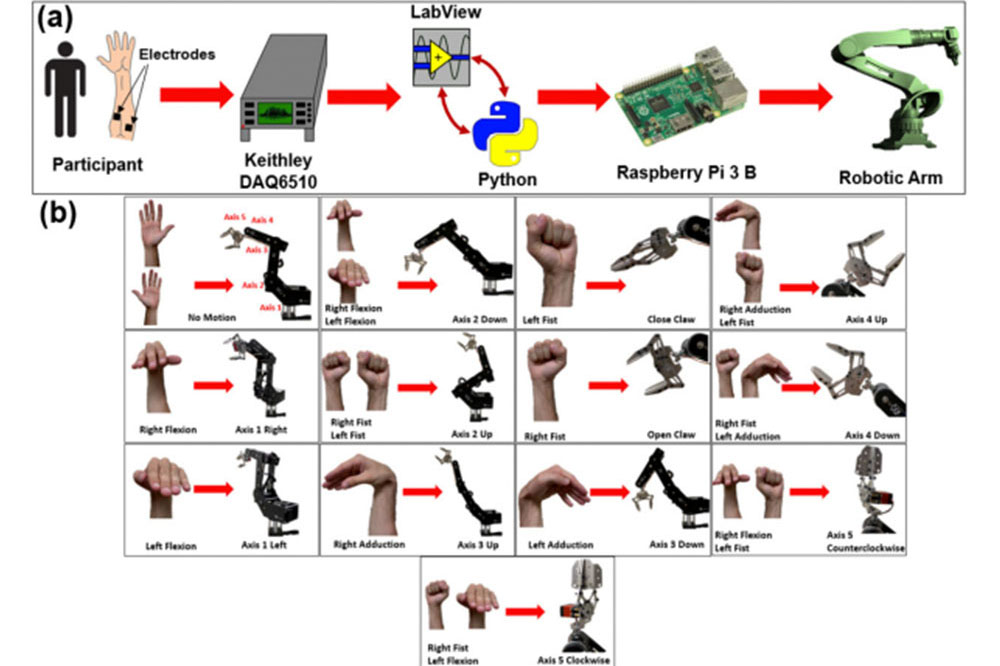September 08, 2021

the robotic arm.
A Mizzou Engineering team has devised a way to control a robot just by moving your hands. What makes the work especially unique is that researchers only used one pair of electrodes on each of a person’s arms to send signals that moved a robotic arm, said Richard Byfield, a third-year PhD student in the Mechanical and Aerospace Engineering Department.

“Before the human body performs a motion, an electronic signal is sent from the brain to the muscle,” he said. “These signals, which can be measured by electromyography (EMG), tell your muscles to fire in certain ways to perform certain motions. If these EMG signals can be measured and decoded, we can then program a robotic arm to perform various actuation just by using corresponding hand motions.”
Using a machine learning classifier, the collected EMG signals were classified into a total of 10 hand motions, such as moving the hand up or down, left or right or making a fist. Two hand motions were designed to make the robot stop what it’s doing.
Ten participants, both male and female, then tested it wearing two electrodes on each forearm. The trained classifier achieved the average accuracy of ~ 96%.
“Usually, to reach that level of accuracy, it requires multiple EMG electrodes all over the arm,” Byfield said. “We were able to do it with just a single pair of electrodes on each forearm.”
The system has numerous potential applications. In industrial settings, a human worker could stand back and use their hands to control a robot as it carried out tasks in dangerous work zones.
It could also lead to new types of hand prosthetics for amputees. With just two electrodes on the forearm or bicep, a person could think about a hand motion and send a signal to the prosthetic device to move in a certain way.
The system could also be used to control a gripper arm on a robotic car.
“We tried to make it as flexible as possible to apply to many areas,” Byfield said. “The system could be adjusted depending on where electrodes are placed and how you want them to correspond to tasks.”
In any situation, Byfield stressed that it’s designed to help humans, not replace them.
“My work is in increasing productivity of humans by making employees more productive,” he said. “So, you can still advance without replacing workers.”
Byfield worked with co-authors Morgan Miller, a Ph.D. student in MAE; Yunchao Xie, a research scientist in MAE; and Jheng-Wun Su, who obtained his Ph.D. in MAE and is now an assistant professor at Slippery Rock University. The team also included a high school student, Richard Weng, who is now an undergraduate at Georgia Tech. The team outlined their findings in the International Journal of Robotics and Control under the guidance of Jian Lin, an associate professor and William R. Kimel Faculty Fellow in mechanical and aerospace engineering.
Highly recommended
Byfield, who is from Rolla, Missouri, earned his bachelor’s degrees in physics and math from Central Methodist University in Fayette, Missouri. He was accepted to three graduate programs but chose Mizzou Engineering because of support he received from Lin during the admissions process.
“Dr. Lin showed an interest in me and recommended me for a Mizzou Engineering graduate fellowship,” Byfield said. “I definitely would recommend Mizzou Engineering. It’s great.”
He especially appreciates the opportunity to work across disciplines. While in the MAE Department, his research crosses into statistics, electrical engineering and computer science. His current research interest is to incorporate human biological signals into the loop of controlling robots. The goal is to develop a human-in-loop robotic system.
“It’s important to be cross-trained between fields,” he said. “Now I can work for a robotics company or work for a mechanical engineering company. It broadens your horizons to do joint research like this. And every engineer needs to understand machine learning, because it is the future.”